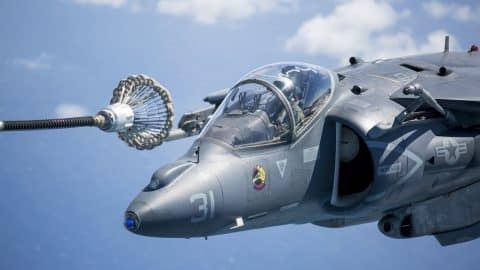
YouTube / Not What You Think
Aerial refueling can be compared to sticking a thread into a needle – albeit ten times harder. Some would even tell you that approaching the tanker plane is the most dangerous part. After all, lining up two huge aircraft while matching up both of their speeds is easier said than done.
So how did the US Air Force make aerial refueling harder than it already is? First, let’s look at the two main methods of aerial refueling:
The boom operator is placed at the rear of the tanker and looks through the window as he operates the boom. Once both planes are lined up, the boom operator can move the boom with a joystick that controls the V-shaped airfoil.

This kind of method is used by the USAF because it transfers fuel at very high rates, perfect for massive aircraft like the B-52s and other large cargo planes.
Primarily used by the Navy, this method relies on the tanker releasing a flexible hose that ends in a conical-shaped drogue that trails behind it. The drogue then stabilizes the hose and acts as a funnel for the probe.

Meanwhile, the receiving aircraft is fitted with a probe on its nose that terminates in a nozzle. The receiving pilot then brings the aircraft into position and carefully maneuvers the probe into the drogue to begin refueling.
The KC-46 Pegasus is an aerial refueling and strategic transport aircraft developed from the Boeing KC-767 tanker that was canceled in 2003 . Since 2013, only 56 have been built out of the 179 tankers initially ordered.

Peggy, as some would call her, has two wing refueling pods located at the end of each wingtip, in addition to a centerline drogue system and a refueling boom. However, the flying boom and its drogue are partially operational at best – especially when compared to the older KC-135s and KC-10s.
In fact, according to the Government Accountability Office, the KC-46 has seven critical deficiencies that could cause death, severe injury, illness, or even damage to the aircraft.

The Pegasus has one major design change: Instead of looking at the boom at the rear, the operator now sits in a remote station in front of the aircraft and looks at the screen. You might think the technology would be pretty good to handle these kinds of operations, but that was not the case when it was being developed and tested.
Under certain atmospheric conditions, like certain sun angles and reflections off water, the cameras would wash out or blackout for periods of time.

This lack of visual clarity has sometimes resulted in undetected contact with the receiving aircraft and even damage to the receiving plane’s body coatings. According to some of its operators, the current RVS works best at night due to the lack of glare.
As a result, the KC-46 has only been able to refuel the F/A-18s using its drogue system in 2021.